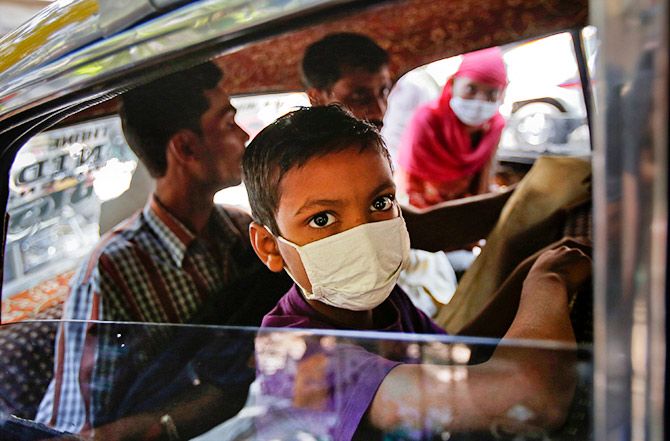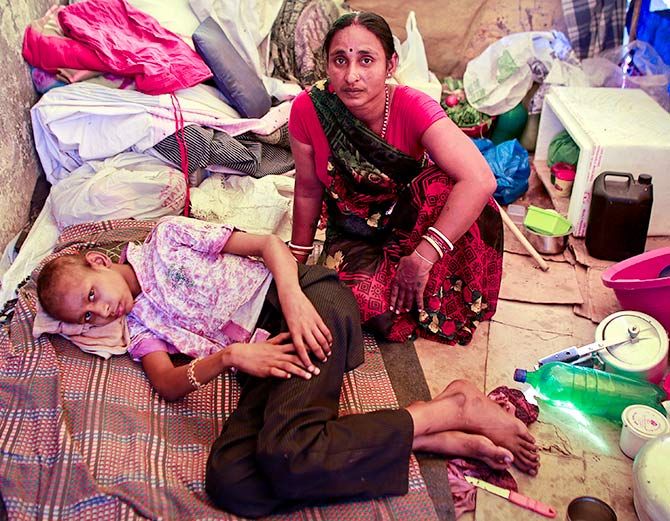Patients from any part of the country will soon need to travel no more than three hours for treatment of the kind available in large metros, reports Gina Krishnan.

A cancer diagnosis usually goes like this. First comes the shock, then you collect your wits and try to figure out how to fight the disease.
You take long leave from work, call for family support and move, bag and baggage, to one of the existing Meccas of oncological care in the country: Tata Memorial Hospital, Mumbai, CMC Vellore, or AIIMS, New Delhi.
You arrange for an additional Rs 400,000 to Rs 500,000 for rent, commute, travel and the like if you happen to be from a place far from these centres.
And all this you do as you battle the anxiety of undergoing weekly rounds of radiotherapy, chemotherapy and, possibly, surgery.

Things, however, are set to change. In partnership with state governments, Tata Trusts has embarked on a mission to bring cancer care to hospitals in tier-II and tier-III towns across the country over a period of two years.
It is one of the biggest such programmes in health care in the world and at the heart of it is a unique distributed care model.
India faces a double whammy on the health care front: While it hasn't yet controlled or eliminated a host of communicable diseases, it is staring at spiralling cases of non-communicable or lifestyle ailments such as diabetes, cardiovascular disease and the Big C.
The Indian Council of Medical Research data shows non-communicable diseases have shot up from 30.5 per cent (Disability Adjusted life years) in 1990 to 55.4 per cent in 2017, with cancer cases being the second largest.
"The numbers are probably grossly under reported, since diagnosis is low and patients present themselves late for treatment," says Arnie Purushotham, medical director of Tata Trusts Cancer programme.
Tata Trusts distributed care model is built around one key idea: proximity, so that the estimated travel time to reach any centre is no more than three hours.

The centres are themselves divided into three categories.
Closest to people in remote areas is a Level-3 hospital, a 40-bed facility that offers chemotherapy, day care and diagnostic centre and is located close to the district hospital.
Some centres will offer radiation as well.
In case a centre is located far from a medical college or district hospital, it will have a mandatory trauma unit .
"Models like mobile radiation vans are interventions that we will consider to ensure optimal use of resources," says Dilpreet Brar, founder and managing director of MedECUBE, a Gurugram-based health services company which is the project manager for the programme.
The Level-2 centre will be a 120-bed facility, close to a medical college, whose departments of education and health care will come together to treat patients.
This hospital will function as a superspeciality care centre.
The Level-1 hospital, a large facility with 300 or more beds, will conduct research and serve as a centre for reading tele-radiology and tele-pathology reports, assessing each case and prescribing the course of treatment.
Four to five Level 1 centres have been planned as of now across the country.
Connecting the various hospitals will be a command centre that will function as a hub for tele-radiology, tele-pathology and patient navigation services for the three levels.
It will not see any patients.
To being with, training has started in Assam, with general physicians learning to recognise cancer symptoms.
The plan is to use screening and diagnostics to treat the disease in early stages so that survival rates improve.
Ninety per cent of the cases are to be handled in L2 and L3.
Only the complicated cases will be handled by specialists at L1.
Once the patient is within the system, all her/his records will go online, and a standardised protocol will be applied.
An oncologist would only be needed for monitoring.
Typically, the patient will undergo 15 to 20 cycles of radiation and chemotherapy in the district at L3.
This way the patient gets required care without having her/his life disrupted.
Only complicated cases get referred from L2 to L1, which is a city-based large facility like the Tata Medical Centre or AIIMS.
"Eventually when the system stabilises, we hope only 5-10 per cent of the cases will go to L1," says Lakshman Sethuraman, head, project management group, Tata Trusts Cancer care programme.
Tata Trusts is taking a tailor-made approach to each state.
So, not all centres will be set up from scratch in every state.
"It is all about partnership with state governments and using existing public health infrastructure," explains Sethuraman.
In Varanasi, for example, an L1 centre is already up and running in partnership with the central government.
An existing brownfield project, Railway Cancer Institute, has been renovated and expanded.
The project is complete, functional and has seen over a thousand patients over the past four months.
A second one at Benaras Hindu University is expected to be commissioned next year.
Spread over 15 acres, it will be a 350-bed facility (with a provision to go up to 500 beds), located 20 minutes from the Railway Hospital.
Some states are bringing in their own tweaks to the model.
Kerala is looking to focus more on setting up command centres.
This will be an apex facility with a number of oncologists, radiologists and pathologists.
The command centre will be fed information from the network's trained technicians and nurses.
Using sophisticated digital infrastructure, high resolution images from L2 and L3 will be transferred to a hub (L1), and reports will go back to the treating physician in 7-8 hours.

For Karnataka, Tata Trusts is creating a holistic document, like an implementation road map, on how the state government can equip itself to handle cancer care over the next 5 to 10 years.
Under-served states -- Jharkhand, Bihar and Odisha -- are considering a distributed care model like that of Assam.
"In Assam, we set up a joint not-for-profit company called Assam Cancer Care Foundation, in which the health minister, principal secretary-health, additional chief secretary-finance are all ex-officio members of the board. There are three directors on the board from the Trust's side," says Sethuraman.
Both the state and Tata Trusts will fund this company, which will build and operate a first-of-its-kind, three-level cancer grid in the state.
The networks can be operated completely by the state or jointly with the Tata Trusts.
An L2 unit will involve coordination between the health and education departments because it falls under the ambit of medical education, and is located close to a medical college.
An L3 unit, on the other hand, falls under the ambit of public health because it is next to a district civil hospital.
For screening, Tata Trusts is trying to get the state governments to start the programme under existing schemes such as the National Tobacco Control programme (for oral health), or train Asha workers, auxiliary nurse and midwife and general physicians in screening for breast and cervical cancer.
The treatment across these centres will follow a standardised protocol set by the National Cancer Grid, which was established by the Department of Atomic Energy and Tata Memorial Hospital, Mumbai, seven years ago.
The protocol is in line with that of the National Comprehensive Cancer Network of the United States, which are uniformly used across the world.
At the new treatment centres, this protocol will be supported by tele-pathology, tele-radiology and Tumour Boards, which will review deviations in a patient's treatment regime.
"This facilitates standardised treatment at every centre across the network," says Dr Brar, a neurologist.
This protocolised care is critical to ensure two things -- one, no matter where the patient goes, he gets the same standard of high quality care and two, survival outcomes are similar.
One of the key aspects of making this system work is to create a digital network so that clinical care effectively takes place on the hospital network system.
All the hospitals will be linked to the command centre seamlessly.
Says Sethuraman, "The command centre is a new concept that has not been done globally. We want to combine everything into one system like an E-ICU with tele-radiology, telepathology, and everything else all in one place."
At least 18 different services will be offered to hospitals in the B2B segment, such as remote instrumentation, data analytics, tele-radiology, tele-pathology, tele-genetics, counselling and normal tele-consulting to help doctors in remote areas.
Setting up digital infrastructure in a greenfield project is easier than changing existing hospitals.
"That is quite a challenge, but essential to ensure data can be transferred where it needs to be looked at," says Purushottam.
Some centres have homegrown software, some don't have any software, so an elegant plug-in is required that will either implement the software from scratch or extract the patient data from existing software and move it across to any centre.
"We will have to look for open source and simpler solutions that remote centres can pick on," says Sethuraman.
Cancer treatment, however, is not affordable to all and Tata Trusts is aware of that.
The kind of patients that are expected will need government schemes and state-subsidised insurance.
"We had begun working on the programme to cover cancer care appropriately before Ayushman Bharat was announced and now we are in a dialogue with the central government," says Sethuraman.
For low-cost providers like Tata Cancer Care Hospitals, it is crucial to work with insurance schemes.
"At present, we are collating all procedures that are over a particular threshold, say, Rs 500, which may be difficult for all to afford.
We are drawing comparisons between various insurance schemes like the NTR Vaidya Sewa, Arogyasri and Atal Amrit Abhiyan, so that we can make recommendations to the Centre on costs and inclusions," adds Purushotham.
As of now, no schedule of charges has been made, but the trust will be largely guided by insurance.
"That is where we will be forced to peg our costs, and the challenge for us will really be to keep them low, otherwise our centres would bleed," says Sethuraman.
Meanwhile, work has begun on training and recruiting staff.
In Assam, the numbers have been worked out, recruitment is on and training protocols have been designed.
"We have also adapted training for workers to take on more responsibility, taking tasks which are of a lower order away from doctors and nurses," explains Purushotham.











